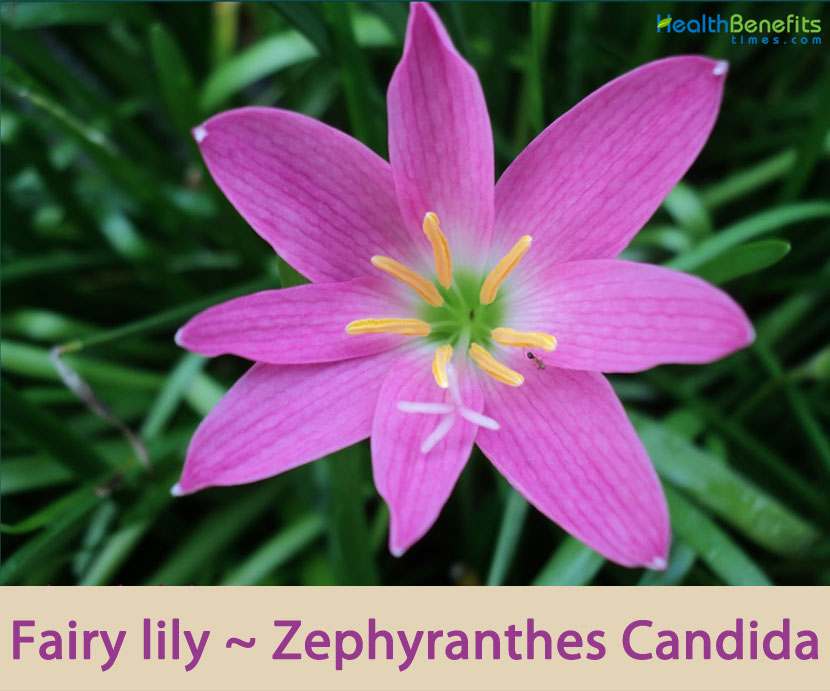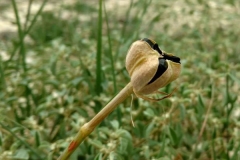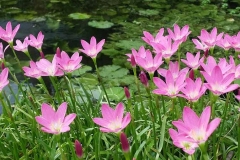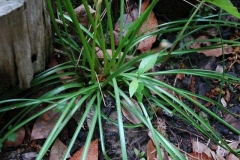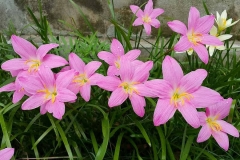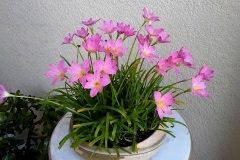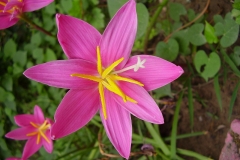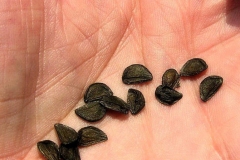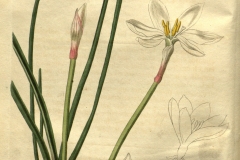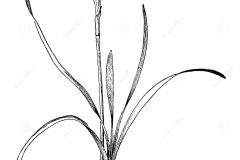| Fairy lily Quick Facts | |
|---|---|
| Name: | Fairy lily |
| Scientific Name: | Zephyranthes Candida |
| Origin | South Africa, the Indian subcontinent, Zimbabwe, Seychelles, central and southern China, Korea, Nansei-shoto |
| Shapes | Capsule with numerous flat, papery seed |
| Health benefits | Good for diabetes, ear and chest ailments, viral infections and breast cancer |
| Name | Fairy lily |
|---|---|
| Scientific Name | Zephyranthes Candida |
| Native | South Africa, the Indian subcontinent, Zimbabwe, Seychelles, central and southern China, Korea, Nansei-shoto (Ryukyu Islands), Bhutan, Solomon Islands, Queensland, Nauru, Tonga, Society Islands, Mariana Islands, southeastern United States (from Texas to North Carolina), the Lesser Antilles, and Peru |
| Common Names | Autumn zephyrlily, white windflower, white rain lily, and Peruvian swamp lily, August Rain Lily, Fairy Lily, Peruvian Swamp-lily, Rain Lily White, White Zephyr Lily, Zephyr Flower, Storm Lily, Sea Onion, Summer Crocus, Zephyr-Lily, Flowers of the western wind |
| Name in Other Languages | Chinese: Cōng lián (蔥蘭) Divehi: Narugis (ނަރުގިސް) Dutch: Witte westenwindbloem English: Autumn zephyrlily, Fairy-lily, Flower-of-the-western-wind, White rain-lily, Zephyr-lily, August rain lily, autumn zephir lily, Peruvian swamp lily, west wind flower, white fairy lily, white zephyr lily French: Lis zephyr German: Weiße Windblume, reinweiße Zephirblume Indonesian: Kembang cokelat Japanese: Tamasudare (タマスダレ) Korean: Huin kkot na do sa peu ran (흰꽃나도사프) Malayalam: Sephrāntas kānṟiḍa (സെഫ്രാൻതസ് കാന്റിഡ) Polish: Zefirant biały Portuguese: Carapitaia, erva-do-vento-e-da-chuva, lírio-do-vento, Russian: Zefirantes belyy (зефирантес белый) Spanish: Azucenita, azucenita de río, azucenita candida Swedish: Vit sefyrlilja Tongan: Feuʻu |
| Plant Growth Habit | Clump-forming herbaceous perennial plant |
| Growing Climates | Occurs around old home sites, on roadsides, in cemeteries, and in lawns |
| Soil | Fast-draining, organic and loamy soils are best. Rain lily is salt sensitive, so saline soils are a big “NO” |
| Plant Size | Up to 10 to 30 centimeters (6 to 12 inches) in height |
| Bulb | Bulbs ovoid, 1.6–2.5cm long, 1.5–2cm in diameter |
| Leaf | Leaves simple, terete, linear, erect basally, arching distally below the middle, 15–30 cm long and × 0.2– 0.4 cm wide, glabrous, hollow, dark green and persist throughout the winter months |
| Flowering season | July to October |
| Flower | Flowers are solitary on an erect scape 3-12 inches in length. The scape is green in color and glabrous. The corolla is white or pinkish in color and rotate. Each flower has 6 white tepals and 6 stamens with yellow anthers. The stigma is capitate |
| Fruit Shape & Size | Capsule with numerous flat, papery seed |
| Plant Parts Used | Flowers, bulbs, whole plant, aerial part |
| Propagation | By dividing bulbs or offsets and from seed |
| Precautions |
|
Plant illustration
Fairy lily is a clump-forming herbaceous perennial plant that normally grows up to 10 to 30 centimeters (6 to 12 inches) in height. The plant is found growing around old home sites, on roadsides, in cemeteries, and in lawns. The plant prefers fast-draining, organic and loamy soils. Rain lily is salt sensitive, so saline soils are a big “NO”. The plants are not picky about soil type and can thrive even in poor soil, though they do better when compost or humus is incorporated into the soil before planting. The site should also be in full to partial sun, with areas that receive sun in the morning and shade in the afternoon or dappled shade for much of the day, which is the most advantageous for the plants.
Water and Fertilizer
As you might gather from their common name, Fairy lily likes a bit of water and you often see a flush of bloom after a rain. The flowers appear consistently throughout the summer as long as they are kept moist. The foliage may even disappear during drought conditions. For best bloom, water regularly and deeply throughout the growing season, particularly from midsummer through fall. No fertilizer is required, though when they’re planted in heavy clay you should spread a 1- to 2-inch layer of finished compost or aged manure around the plants before they emerge in the spring.
Leaves
Leaves are simple, terete, linear, erect, basally, arching distally below the middle, 15–30 cm long and 0.2– 0.4 cm wide, glabrous, hollow, dark green and persist throughout the winter months.
| Leaf arrangement | Most emerge from the soil, usually without a stem |
| Leaf type | Simple |
| Leaf margin | Entire |
| Leaf shape | Linear |
| Leaf venation | Parallel |
| Leaf type and persistence | Deciduous |
| Leaf blade length | 2 to 4 inches; 4 to 8 inches |
| Leaf color | Green |
| Fall color | No fall color change |
| Fall characteristic | Not showy |
Flower
Flowers are solitary on an erect scape 3-12 inches in length. The scape is green in color and glabrous. The corolla is white or pinkish in color and rotate. Each flower has 6 white tepals and 6 stamens with yellow anthers. The stigma is capitate. Flowering normally takes place in between July to October.
| Flower color | Orange; pink; red; yellow; white; rose |
| Flower characteristic | Summer flowering; fall flowering; spring flowering |
Fruit
Fertile flowers are followed by capsule with numerous flat, papery seed.
| Fruit shape | Oval |
| Fruit length | Unknown |
| Fruit cover | Dry or hard |
| Fruit color | Unknown |
| Fruit characteristic | Inconspicuous and not showy |
Health benefits of Fairy lily
There are some diseases that are curable using Fairy lily (Zephyranthes candida), including the following:
1. Relieve insomnia
When bedtime has arrived but you haven’t been able to close your eyes, there are also natural ways to cope with the hard bed, one of them with Fairy lily. Take 10 grams of leaves, wash with clean water. Heat 500 ml of water on the stove, insert the ingredients into it. Leave it in boiling water for 5 minutes, lift. Drink it in the morning and evening also.
2. Cure headache
If you suffer from dizziness caused by a medical condition, try consuming a traditional herb. Boil 15 grams Fairy lily along with 450 ml of water. Wait for the water to boil over ¼ hours, allow cooling. Drink immediately, to relieve a headache.
3. Cure epilepsy
To prevent epilepsy, you can use natural ingredients. Heat two cups of water using low heat, stir in 10 grams of brown sugar and a bit of graining of stones. Simmer for a few moments, lift. Give this drink to epileptics per day.
4. Improve liver function in people with hepatitis A
Fairy lily during early stage turns out to be effective in addressing impaired liver function. With enough drinking water decoction of the plant is 10 grams. Do regularly until symptoms diminish and disappear.
5. Lower the fever
Little flower proved to be able to reduce high body heat in children. The flowers are then mashed paste on the brow edge.
6. Addressing the spasm in children
Fairy lily can also be used as a medicine beyond children who experience seizures. In addition, it does not matter if Fairy lily already boiled taken by sufferers.
Traditional uses and benefits of Fairy lily
- In China, it is used for treating breast cancer.
- In India, bulb extract of Z.rosea and Z. flava used for treatment of diabetes, ear and chest ailments and viral infections.
- The leaves of Z. candida have been used by indigenous peoples in Africa for treatment of diabetes mellitus.
Other Facts
- Fairy lilies are commonly grown for decorative purposes in gardens, although they have become a weed in some parts of some countries.
- Fairy lilies are evergreen and are generally grown as a perennial, although in cold climates they are usually grown as annuals.
- This versatile plant can be used in mass plantings, in rock gardens, as a container plant or partially submerged in the water garden.
References:
https://www.itis.gov/servlet/SingleRpt/SingleRpt?search_topic=TSN&search_value=505793#null
https://www.missouribotanicalgarden.org/PlantFinder/PlantFinderDetails.aspx?kempercode=c747
https://gd.eppo.int/taxon/ZEPCA
https://en.wikipedia.org/wiki/Zephyranthes_candida
http://www.theplantlist.org/tpl1.1/record/kew-291809
https://indiabiodiversity.org/species/show/231498
https://plants.usda.gov/home/plantProfile?symbol=ZECA
https://www.flowersofindia.net/catalog/slides/White%20Rain%20Lily.html
http://floraofalabama.org/Plant.aspx?id=4434


